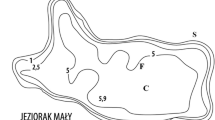Abstract
An increased load of domestic wastewater to Lake Trehörningen induced oxygen-poor water conditions and the development of a reduced sulphide-rich sediment layer. Severely polluted, the lake did not recover, even after advanced wastewater treatment and sewage diversion. Restoration measures with suction dredging and macrophyte elimination were applied in 1975 and 1976. The loose topmost sediment was pumped into an embanked and overgrown bay which was used as a settling pond. The activities also included a restoration of the shorelines. This project is the largest restoration programme carried out in Sweden on a single lake, corresponding to a cost of about US $2 000 000.
The restoration of Lake Trehörningen was followed by a highly intensive research programme which included water chemistry and algal assays. The concentrations of phosphate and total phosphorus decreased by 73 and 50% respectively, as summer average values, two years after the restoration. However, the concentrations of phosphorus are still too high to permit this element to act as a prime algal growth-limiting nutrient. The algal biomass has also remained at the same magnitude as before the restoration. Nitrate-N concentrations showed a tenfold increase, based on average values for the summer period. However, based on the results of the algal assays, a rapid and marked response was obvious, with a drastic decline in the algal growth potential.
In addition, the water quality of the tributaries was frequently of an objectionable character (0.1–0.2 g P m−3). The nutrient loading from these sources exceeds the critical level for the lake, and measures have now been carried out to treat all the inflowing waters for the removal of phosphorus.
Similar content being viewed by others
References
Bengtsson, L., Fleischer, S., Lindmark, G. & Ripl, W., 1975. Lake Trummen restoration project. I. Water and sediment chemistry. Verh. Int. Verein. Limnol. 19: 1080–1087.
Björk, S., 1972. Swedish lake restoration program gets results. Ambio 1: 153–165.
Claesson, A. & Forsberg, Å., 1978. Algal assay procedure with one or five species. Minitest. Mitt. Int. Verein. Limnol. 21: 21–30.
Claesson, A. & Ryding, S.-O., 1980. Characterization of the recovery processes in hypertrophic lakes in terms of actual (lake water)- and potential (algal assay) chlorophyll. In: Barica, J. & Mur, L. R. (Eds.) Hypertrophic Ecosystems, pp. 281–289. Developments in Hydrobiology, Vol. 2. Junk, The Hague.
Cronberg, G., Gelin, C. & Larsson, K., 1975. Lake Trummen restoration project. II. Bacteria, phytoplankton and phytoplankton productivity. Verh. Int. Verein. Limnol. 19: 1088–1096.
Dunkers, K. & Söbderlund, H., 1978. Sjörestaurering och dagvattenbehandling -nya metoder — nya aspekter. Väg- och vattenbyggaren 10: 31–32.
Dunst, R. C., Born, S. M., Uttormark, P. D., Smith, S. A., Nichols, S. A., Peterson, J. O., Knauer, D. R., Serns, S. L., Winter, D. R. & Wirth, T. L., 1974. Lake rehabilitation techniques and experiences. Dept. Nat. Resour., Tech. Bull. No 75, Madison, Wisconsin. 179 pp.
Orrje & Co, Skandiaconsult, 1973. Teknisk beskrivning över restaurcringen av sjbn Trehörningen. Orrje & Co, Skandiaconsult, 52.0011–08, 1973.01.18. 21 pp.
Ryding, S.-O., 1978. Recovery of polluted lakes. Loading, water quality and responses to nutrient reduction. Acta Univ. Upsal., Abstracts of Uppsala dissertations, No. 459, 44 pp.
Ryding, S.-O., 1980. Monitoring of inland waters. OECD eutrophication programme. The Nordic project. Scandinavian Council for Applied Research, Secretariat of Environmental Sciences, Publ. 1980: 2. 207 pp.
Ryding, S.-O., 1981. Reversibility of man-induced eutrophication. Experiences of a lake recovery study in Sweden. Int. Revue ges. Hydrobiol. 66: 449–503.
Ryding, S.-O. & Forsberg, C., 1977. Sediments as a nutrient source in shallow, polluted lakes. In: Golterman, H. L. (Ed.) Interactions between Sediments and Fresh Water, pp. 227–234. Junk, The Hague.
Ryding, S.-O. & Forsberg, C., 1980a. Short-term load-response relationships in shallow, polluted lakes. In: Barica, J. & Mur, L. R., (Eds.) Hypertrophic Ecosystems, pp. 95–103. Developments in Hydrobiology, Vol. 2. Junk, The Hague.
Ryding, S.-O. & Forsberg, C., 1980b. Hydrologi, ämnestrans-port och vattenkvalitet i Finjasjön 1976–1978. Hässleholms Kommun, Gatukontoret, April 1980. 41 pp.
Vollenweider, R. A., 1968. Scientific fundamentals of the eutrophication of lakes and flowing waters with special reference to nitrogen and phosphorus as factors in eutrophication. OECD DASJCSI 68.27, Paris. 254 pp.
Vollenweider, R. A., 1975. Input-output models with special reference to the phosphorus loading concept in limnology. Schweiz. Z. Hydrol. 37: 53–84.
Author information
Authors and Affiliations
Rights and permissions
About this article
Cite this article
Ryding, SO. Lake Trehörningen restoration project. Changes in water quality after sediment dredging. Hydrobiologia 91, 549–558 (1982). https://doi.org/10.1007/BF00000053
Issue Date:
DOI: https://doi.org/10.1007/BF00000053




